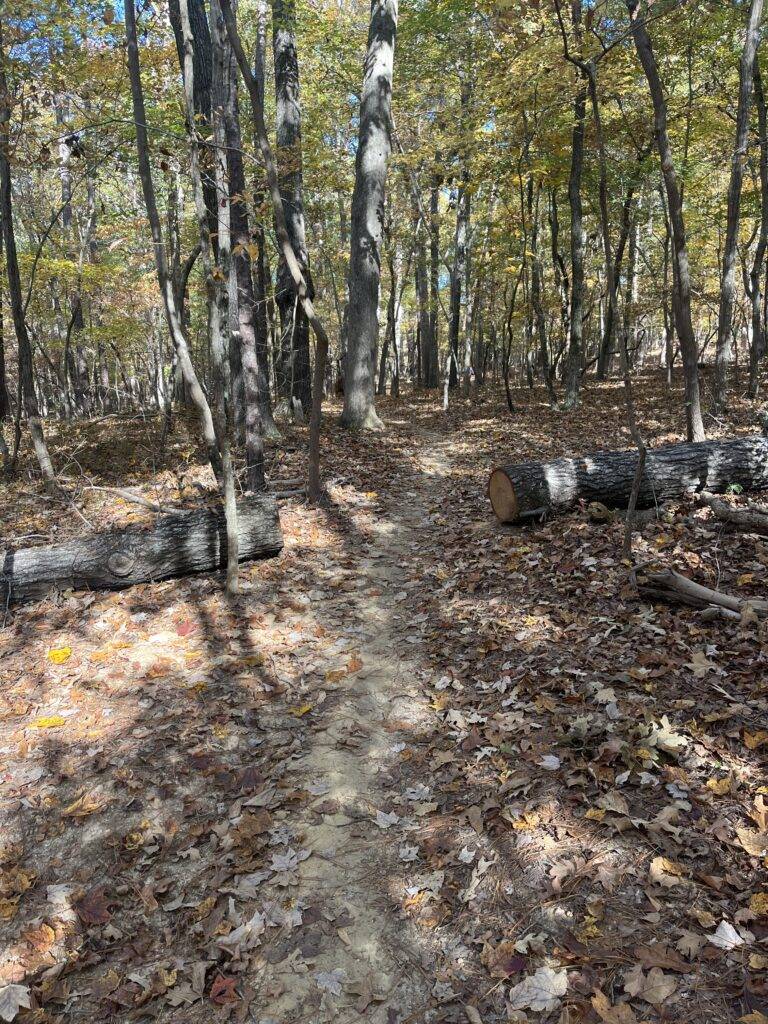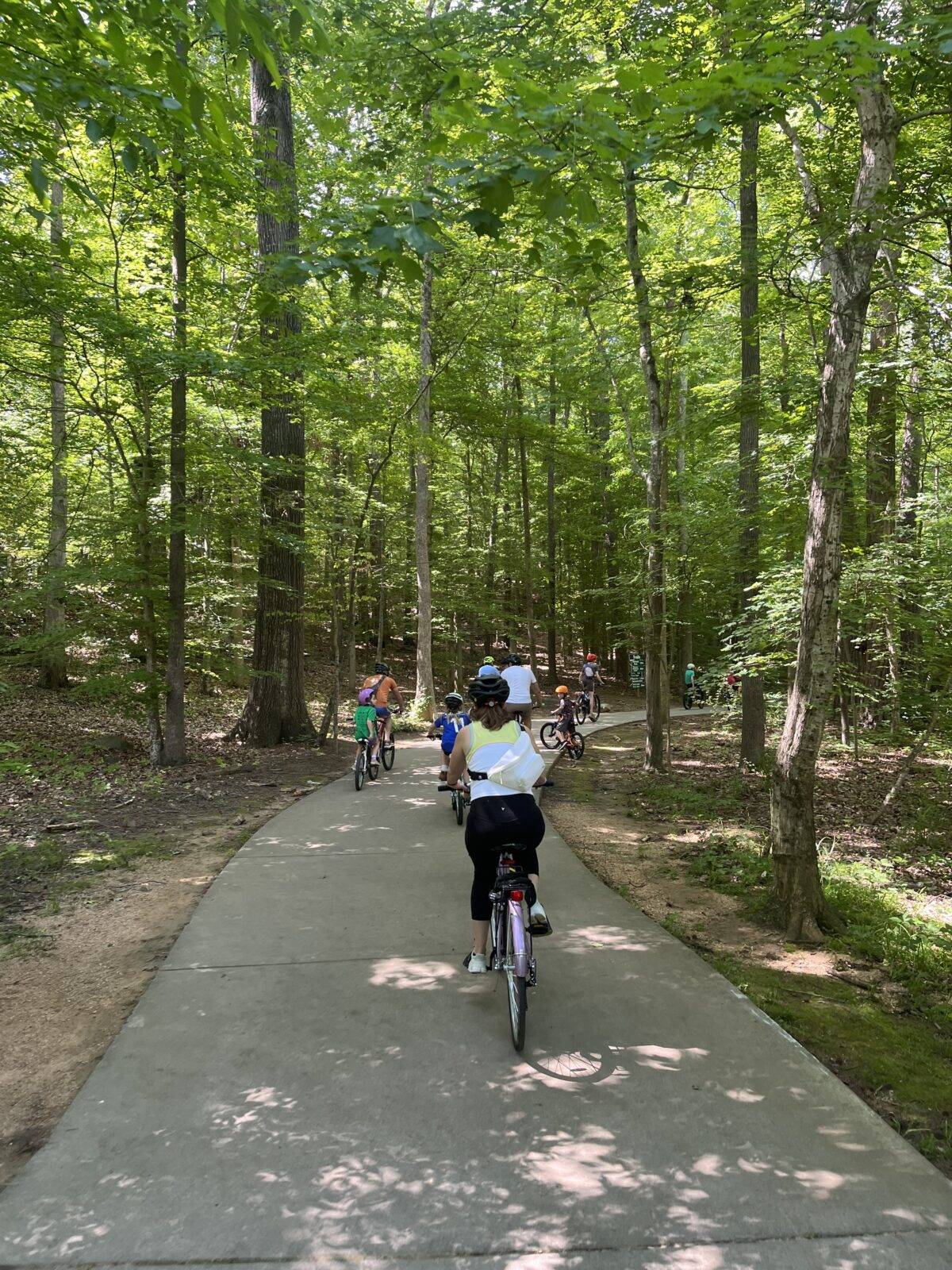We are beginning a new series to consider policy questions that will be addressed by the Chapel Hill and Carrboro Town Councils in the next two years. As we always do at Triangle Blog Blog, we will offer our opinions, but we’ll also point you to primary source documents so you can make your own judgment.
What is a greenway?
Greenways, also called linear parks, are corridors of open space that protect natural areas, connect communities, and provide recreation and transportation opportunities for people. Many greenways are built on or alongside abandoned railroad tracks, power lines, and sewer lines.
In Chapel Hill and Carrboro, we have several greenways, mostly built along sewer lines that are controlled by the Orange Water and Sewer Authority, which services southern Orange County. The longest greenway, the Bolin Creek Trail, runs 2.5 miles, including the Tanyard Branch extension to Northside, while other greenways, like the .8 mile Lower Booker Creek Trail, are significantly shorter.
Do people like greenways?
Absolutely. They are among our community’s most popular amenities. Most people use greenways for exercise and socializing and, as our network grows we’re beginning to see people use it to quickly get from place to place as well.
What are the benefits of greenways?
Too many to list here. Greenways are multi-solving projects, one of our best ways to address climate change, create equitable access to parks and greenspace, improve our community’s health, and to make our local economy more resilient. There’s a reason that communities all over North Carolina, from Brevard to Fayetteville, treasure their greenways and seek to expand them.
What are the obstacles to adding more greenways?
Like any public works project, there are two key obstacles to adding greeways:
- Money. It costs money to build greenways, a few million dollars per mile. Fortunately, federal and state grant money is available to pay for the costs of construction, but that requires:
- Plans. Before we build new greenways, we need to know where they will go. In the planning process, we start with very general plans—outlining a broad vision for how we can add on to our existing greenways to create a network of connected paths—before getting into the specific details, like engineering and construction plans.
What plans are Chapel Hill and Carrboro making to build more greenways?
For people who love greenways, this is an exciting time to be living in Chapel Hill and Carrboro. Both communities are planning extensive expansions of their existing greenway network in the coming years, which means that by the end of the decade we could potentially double the number of miles of greenways in our community.
In Carrboro, the town council voted on Tuesday, October 17 to select the Creekside Alignment as the preferred alternative for Phase 3 and 4 of the Bolin Creek Greenway. This vote, 14 years (!) in the making, is a critical step for Carrboro, because it means that they can begin pursuing grants to fund the design and eventual construction of the greenway.
In Chapel Hill, the town recently received a $1.3 million federal grant to plan an “everywhere to everywhere” greenway network. This is a big deal because the federal government typically only gives money to projects they imagine funding in the future. If all goes well, Chapel Hill could receive a much more substantial federal grant to actually build their planned greenway network. (Here is the town’s winning application, which includes a timeline for the greenways plan).
Where do the candidates stand on greenways?
Greenways are popular, so it’s not surprising that all of the candidates say they love greenways. But supporting greenways in theory is very different from supporting them in practice. In Chapel Hill, there’s no specific project under discussion, so supporting greenways is easy. In Carrboro, candidates are weighing in on a specific project, phase 3 and 4 of the Bolin Creek Greenway.
Carrboro
The October 17 vote to approve the creekside alignment for the Bolin Creek Greenway was the culmination of almost two years of work by several organizations, including NEXT, the Chapel Hill-Carrboro chapter of the Democratic Socialists of America, and, ahem, us. Canvassing by the DSA, greenway walks and guest speakers hosted by NEXT, and, we believe, our fact-checking articles helped get us to this point.
But this vote isn’t the end of the process. Depending on who is elected, we will either have a council that is strongly in favor of greenways, or one that is not particularly interested in prioritizing greenways. This is especially true for the creekside alignment of phase 3 and 4 of the Bolin Creek greenway.
Barbara Foushee and Eliazar Posada voted for the creekside alignment.
Catherine Fray and Jason Merrill are also strong supporters of the creekside alignment, and Fray spoke in favor of it at the October 17 meeting of the Carrboro Town Council.
The other two candidates for council, April Mills and Stephane Wade, have expressed concerns about the creekside alignment for the greenway, citing many of the issues the Friends of Bolin Creek have listed for years. While they have not explicitly stated opposition to the creekside alignment, it is unlikely that they would support any steps toward realizing the completion of the greenway along Bolin Creek.
Chapel Hill
In Chapel Hill, all of the candidates support greenways, but disagree about how to build them.
One of the key components of the Complete Community framework is the “everywhere to everywhere” greenway network that will be constructed through a combination of federal and state grants and, importantly, local tax dollars. We will also expand access to our greenway network with new development. While state law doesn’t permit us to require developers to build greenways on property they don’t own, we can ask them to incorporate greenway access on their property, as the town council recently did for the Chapel Hill Crossings project.
As supporters of the Complete Community framework, mayoral candidate Jess Anderson, and council candidates Melissa McCullough, Amy Ryan, Theodore Nollert, Jon Mitchell, and Erik Valera all back using greenways as transportation networks and recreational facilities. If elected, we can expect them to prioritize the expansion of our current greenway network.
Adam Searing, who first ran for council in part because he wanted to preserve unofficial mountain bike trails on the Greene Tract, believes that we should prioritize the construction of unpaved, “natural surface” trails over greenways. In October, he prepared a document extolling the benefits of these trails, which he claims are easier to construct and much less expensive than the greenway network his opponents are discussing.

Natural surface trails are great, and Chapel Hill already has a lot of them. But, as Searing notes, they are a complement to a network of paved greenways, which cost a lot more money, not a replacement for them. Natural surface trails can be expensive to maintain, are often inaccessible to people who don’t own fancy bikes, and, as mountain bikers in the area know, have to close for extended periods of time whenever there’s a heavy rain.
While an everywhere to everywhere greenway network would help transform how people in Chapel Hill get around, adding more natural surface trails will mostly benefit people who already have a lot of options when it comes to walking or mountain biking.
None of the council candidates aligned with Searing have lent their support to the Everywhere to Everywhere Greenways plan. Renuka Soll, the chair of the Chapel Hill Parks, Recreation, and Greenways Commission, supports expanding our greenway network, but not in the context of the Complete Community framework or the recent federal grant.
Breckany Eckhardt supports Searing’s “natural surface” trail plan, and suggests that supporting such trails could be a money-saving venture, a way to “design smart,” as she puts it. Elizabeth Sharp does not discuss greenways at all on her website, and does not seem to have made greenways a priority in her platform. Likewise, David Adams only mentions that we need to “connect and expand our greenway system” on his website. Jeffrey Hoagland does not appear to have a position on greenways.
Why does this matter?
Greenways are incredibly popular, but it requires a lot of planning, design, and engineering work to make them a reality. It was a big deal that Chapel Hill received a federal grant to plan a greenway network, and going through with the Everywhere to Everywhere Greenway plan could be the difference between staying at our current pace, adding a mile or so of greenways every decade, and a transformative project that would change how everyone gets around in town. Likewise, by adopting the Creekside alignment for the Bolin Creek Greenway, the Carrboro Town Council is now eligible to begin plans to build the greenway, which will connect with Chapel Hill’s Bolin Creek Greenway, providing a car-free connection for thousands of people to get to and from schools, shops, and work.


